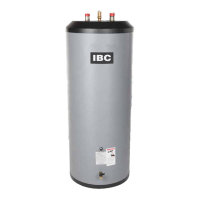INSTALLATION AND OPERATION INSTRUCTIONS
10
IBC INDIRECT WATER HEATERS - ALL MODELS
TEMPERATURE RESISTANCE TEMPERATURE RESISTANCE
°F °C Ω °F °C Ω
30 -1 34,558 115 46 4,184
35 2 29,996 120 49 3,760
40 4 26,099 125 52 3,383
45 7 22,763 130 54 3,050
50 10 19,900 135 57 2,754
55 13 17,436 140 60 2,490
60 16 15,311 145 63 2,255
65 18 13,474 150 66 2,045
70 21 11,883 155 68 1,857
75 24 10,501 160 71 1,689
80 27 9,299 165 74 1,538
85 29 8,250 170 77 1,403
90 32 7,334 175 79 1,281
95 35 6,532 180 82 1,172
100 38 5,828 185 85 1,073
105 41 5,210 190 88 983
110 43 4,665 195 91 903
Table 4: Temperature Sensor resistance values
5) - Operation
Startup
After the water heater has been plumbed and wired, and the boiler water piping
is purged of air, the water heater is ready to be started.
1. Follow the boiler installation instructions to place the boiler in operation.
2. In the “Installer Setup Menu”, go to “Heat Load Conguration” and “Dene
Load 1” as DHW. Move to “Congure Load 1” and enter the appropriate
values for the system you are working with.
3. When the actual tank temperature is below the DHW “Tank Set Point”
temperature, the boiler will turn on the DHW pump or valve and re up its
burner. It will then throttle up in order to raise the boiler water temperature to
the “DHW Supply Set Point” temperature. As the tank heats, the boiler will
throttle down, and when the tank temperature reaches Set Point, the boiler
will shut off (if there are no other loads calling for heat) and turn off the DHW
pumps and/or valves.
4. If the boiler switches over to satisfy other heating loads, and the tank
temperature falls below the Tank Set Point temperature, it will return to DHW
operation if the DHW Priority setting is higher than the other heating loads.
Temperature Adjustment
The tank sensor controls the maximum water temperature in the water heater. If
it is set too high, the resulting hot water can cause painful scalding with possible
serious and permanent injury. The temperature at which this occurs varies with
a person’s age, and the length of time in contact with the hot water. The slower
response time of infants, older, or handicapped people increases the hazard for
them.
WARNING
IBC water heaters are
supplied with a 10kΩ
thermistor sensor to be
inserted into the temperature
well of the tank, and secured
with a retainer clip or cap.
The thermistor must be solidy
afxed so as to prevent it
from falling out or being
pulled out. If the sensor
is pulled out of the well, a
continuous call for hot water
will be generated, resulting in
elevated tank temperatures
and risk of scalding.
NOTE
When programming the IBC
DHW load in the Congure
Load Menu, there are three
critical settings that will result
in satisfactory operation.
DHW Supply Set Point
The temperature to which the
boiler heats the water that it
sends into the Water heater coil.
Must be at least 20°F higher
than the DHW Tank Set Point
temperature.
DHW Tank Set Point
The temperature the end
user gets from the faucet.
Recommended to be no higher
than 120°F to prevent scalding.
Maximum Supply Temp
The highest DHW Supply Set
Point temperature the boiler will
allow. Should be at least 20°F
higher than the DHW Supply
Set Point temperature.
Supply Diff’l Temp
The variance the control allows
in the DHW Supply Set Point.
Trial setting of 20°F. Set higher
to reduce short-cycling around
the DHW Supply Set Point.
Tank Diff’l Temp
The variance the control allows
in the DHW Tank Set Point. Trial
setting of 10°F. Set lower for
tighter Tank temperature control.

